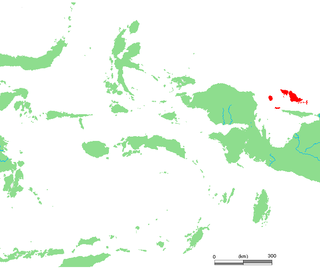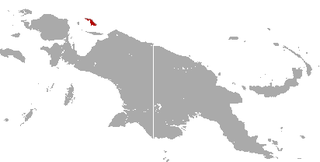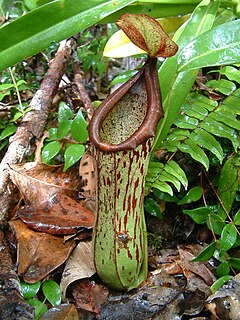Related Research Articles

Papua, is a province of Indonesia, comprising the northern coast of Western New Guinea roughly follows the borders of Papuan customary region of Tabi Saireri. It is bordered by the sovereign state of Papua New Guinea to the east, the Pacific Ocean to the north, Cenderawasih Bay to the west, and the provinces of Central Papua and Highland Papua to the south. The province also shares maritime boundaries with Palau in the Pacific. Following the splitting off of twenty regencies to create the three new provinces of Central Papua, Highland Papua, and South Papua on 30 June 2022, the residual province is divided into eight regencies (kabupaten) and one city (kota), the latter being the provincial capital of Jayapura. The province has a large potential in natural resources, such as gold, nickel, petroleum, etc. Papua, along with four other Papuan provinces, has a higher degree of autonomy level compared to other Indonesian provinces.

The Schouten Islands are an island group of Papua province, eastern Indonesia in the Cenderawasih Bay 50 km off the north-western coast of the island of New Guinea. The group consists of the main islands of Biak, Supiori and Numfor, and numerous smaller islands, mostly covered in rain forest.

West Papua, formerly Irian Jaya Barat, is a province of Indonesia. It covers the two western peninsulas of the island of New Guinea, the Bird's Head Peninsula and the Bomberai Peninsula, along with nearby islands. The province is bordered to the north by the Pacific Ocean, to the west by the Halmahera Sea and the Ceram Sea, to the south by the Banda Sea, and to the east by the province of Central Papua and the Cenderawasih Bay. Manokwari is the province's capital, while Sorong is its largest city. West Papua is the second-least populous province in Indonesia, with a population of 1,134,068 at the 2020 Census; the official estimate for mid 2021 was 1,156,840.

Biak is an island located in Cenderawasih Bay near the northern coast of Papua, an Indonesian province, and is just northwest of New Guinea. Biak is the largest island in its small archipelago, and has many atolls, reefs, and corals.

The South Halmahera–West New Guinea (SHWNG) languages are a branch of the Malayo-Polynesian languages, found in the islands and along the shores of the Halmahera Sea in the Indonesian province of North Maluku and of Cenderawasih Bay in the provinces of Papua and West Papua. There are 38 languages.

Sorong is the largest city of the Indonesian province of West Papua. The city is located on the western tip of the island of New Guinea with its only land borders being with Sorong Regency. It is the gateway to Indonesia's Raja Ampat Islands, species rich coral reef islands in an area considered the heart of the world's coral reef biodiversity. It also is the logistics hub for Indonesia's thriving eastern oil and gas frontier. Sorong has experienced exponential growth since 2010, and further growth is anticipated as Sorong becomes linked by road to other frontier towns in Papua's Bird's Head Peninsula. The city had a population of 190,625 at the 2010 Census; the latest official estimate is 254,294. It is served by Domine Eduard Osok Airport.

Cenderawasih Bay, also known as Sarera Bay and formerly Geelvink Bay, is a large bay in northern Province of Papua, Central Papua and West Papua, New Guinea, Indonesia.

Frans Kaisiepo International Airport, is an airport in Biak, Papua, Indonesia. It is also known as Mokmer Airport. The airport is named after Frans Kaisiepo (1921–1979), the fourth Governor of Papua. The airport has seven aircraft parking slots, of which two are capable of handling wide-body aircraft, and a small terminal without jet bridges. The airport's only runway is 3,571m long, designated as 11/29.
The angulate pipistrelle, also known as the New Guinea pipistrelle, is a species of vesper bat found in Papua New Guinea and the Solomon Islands.

Frans Kaisiepo was a Papuan politician and Indonesian nationalist. He served as the fourth Governor of Papua Province. In 1993, Kaisiepo was posthumously declared a National Hero of Indonesia for his lifelong efforts to unite West Irian with Indonesia. As the representative of Papua province, he was involved in the Malino Conference, where the formation of the United States of Indonesia was discussed.

The Biak glider is a species of marsupial in the family Petauridae. It is endemic to the Schouten Islands in the western region of Papua Province, Indonesia. It was formerly considered to be a subspecies of Petaurus breviceps ; there is still uncertainty regarding its status as a distinct species.

The Biak roundleaf bat or Geelvinck Bay leaf-nosed bat is a species of bat in the family Hipposideridae. It is endemic to the Biak Islands and Cenderawasih Bay area of Papua Province, located in Western New Guinea, Indonesia.
Biak, also known as Biak-Numfor, Noefoor, Mafoor, Mefoor, Nufoor, Mafoorsch, Myfoorsch and Noefoorsch, is an Austronesian language of the South Halmahera-West New Guinea subgroup of the Eastern Malayo-Polynesian languages.
The Cenderawasih languages, approximately synonymous with West New Guinea languages, are a branch of Austronesian languages of Indonesia, found in the islands and shoreline of Cenderawasih Bay in the provinces of West Papua and Papua.

The blue-eyed spotted cuscus or Biak spotted cuscus is a species of critically endangered marsupial in the family Phalangeridae.
The 2010 Papua earthquake occurred on June 16 at 12:16 local time in Papua province of Indonesia. The magnitude 7.0 mainshock was preceded by an Mw 6.2 foreshock 10 minutes earlier, and was followed 42 minutes later by an Mw 6.6 aftershock.
The 1996 Biak earthquake, or the 1996 Irian Jaya earthquake, occurred on February 17 at 14:59:30 local time near Biak Island, Indonesia. The earthquake had a moment magnitude of 8.2 and a maximum Mercalli intensity of IX (Violent). The run-up height of the generated tsunami reached 7 meters (23 ft). One-hundred and sixty-six people were reported dead, 423 were injured, and 5,090 were made homeless.

Persatuan Sepakbola Biak dan Sekitarnya, commonly known as PSBS Biak, is an Indonesian football club based in Biak Numfor Regency, Papua, Indonesia. The club currently plays in Liga 2.
Mapia is an extinct Micronesian language of Indonesia. It was spoken on Mapia Atoll, 180 km north of the coast of West Papua. The population emigrated to Micronesia early in the 20th century, and then assimilated linguistically; the only speaker as of 2000 was an elderly man who had remained behind on the island. The rest of the population of Mapia are now Biak-speaking immigrants.

Nepenthes biak is a tropical pitcher plant endemic to the Indonesian island of Biak, after which it is named. Biak is a member of the Schouten Islands, located in Cenderawasih Bay, and is administered as part of Biak Numfor Regency, Papua Province. Nepenthes biak grows near sea level, usually on limestone coastal cliffs though occasionally as an epiphyte on mangrove trees.
References
- ↑ Kamma, Freerk Christiaans (1954). De Messiaanse Koréri-bewegingen in het Biaks-Noemfoorse cultuurgebied. J. N. Voorhoeve. pp. 39 ff.